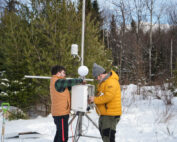Why Do Certain Leaves Change Color?
2018-10-22 11:54:57.000 – Chloe Boehm, Summit Intern
After spectacular fall foliage for the last few weeks, winter weather has started to descend upon the mountain and with that comes the end of the beautiful colors on the trees. Reflecting back on the past few weeks, the summit has a perfect vantage point on clear days to view how the colors change based on elevation. The difference between the valleys and as you look up the ravines is very well defined. Once you reach up to 4000-5000 feet, the trees tend to stay green all the way through the winter. This raises the question of why. The simple answer is that the types of trees differ at higher elevations than in the valleys but I was interested in discovering what about those higher elevation trees causes them to not change colors.
First in an attempt to answer this question, it is important to discuss why some trees lose their leaves during the winter. New England winters can be very harsh and many trees need to prepare for them so they can survive until spring. This involves trees reducing themselves only to the essential and toughest parts. The fluid that flows through the leaves is very thin and thus very susceptible to freezing. It would take a lot of energy for the tree to prevent that from happening so instead of expending large amounts of energy to keep their leaves healthy, trees will drop their leaves and seal the spots on the branches where they had been attached.
Some trees, such as evergreens do not need to do this. Their needles are coated with a wax that helps protect against the cold as well as anti-freeze chemicals in their cells that keep fluid from freezing. Thus evergreens can hold on to their needles even as temperatures dip below freezing.
But how is this related to colorful leaves? Plants and trees are colored green by a pigment called chlorophyll. Chlorophyll is important for plants to be able to make food using sunlight. During the spring and summer, there is lots of sunlight so plants and trees make lots of chlorophyll which turns them green. However, chlorophyll is costly to make. In an effort to conserve energy before heading into the winter, trees stop making chlorophyll in the fall. As the concentration of the chlorophyll pigment starts to wane, other pigments take over, carotenoids and anthocyanins. Carotenoids create yellow, orange, and brown colors. They produce these colors in flowers, the roots of carrots, and even the rinds/peels of pumpkins and bananas. Anthocyanins on the other hand create red, pink, and purple colors. Both are always present in trees, they are just usually masked by the presence of chlorophyll. Once the concentration of chlorophyll wanes, carotenoids or anthocyanins take over, giving the leaves a vibrant change in color. Certain trees have differing concentrations of these pigments, thus giving the fall foliage a huge variety of colors.
So since coniferous trees don’t need to drop their needles before winter, the chlorophyll content stays high. This also allows them to continue to make small amounts of energy through photosynthesis during the winter which helps keep them alive. This keeps coniferous trees green during the fall and winter as deciduous trees turn myriad different colors. Since higher elevations are dominated by coniferous trees, partially due to their ability to stay alive during very harsh conditions, as you look up the Great Gulf, Tuckermans, or any other mountain side, you see a distinct change in the colors from the valley floor.
Chloe Boehm, Summit Intern
Life as a Mesonet and Information Systems Technician
Life as a Mesonet and Information Systems Technician By Colby Morris Installing an automated weather station with MWOBS Director of Technology Keith Garrett (left). The instrument I am holding is a temperature sensor.
Supporter Spotlight: Ryan Shepard
Supporter Spotlight: Ryan Shepard By Ryan Shepard and Carissa Milliman Ever since I was a kid, living in Western New York and growing up with lake effect snow, I thought harsh weather was incredibly
Supporter Spotlight: Erik Rider
Supporter Spotlight: Erik Rider By Wendy Almeida For Erik Rider, supporting Mount Washington Observatory comes from a lifelong fascination with weather and how it shapes daily life. Growing up along the Massachusetts coast, he


